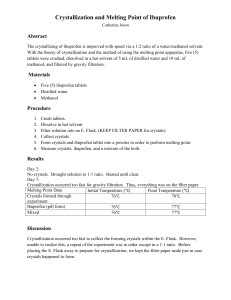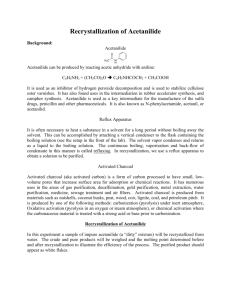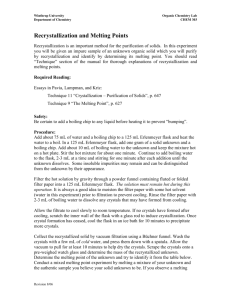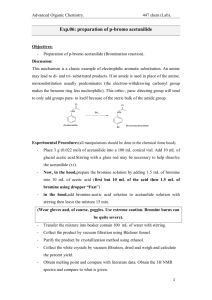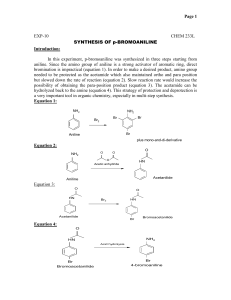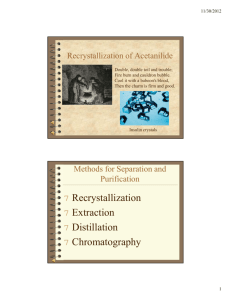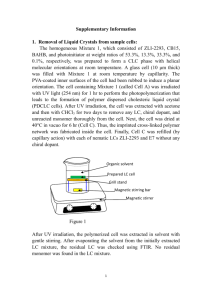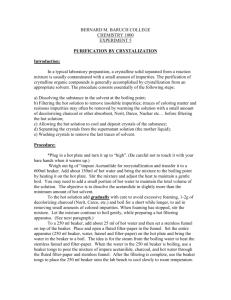Recrystallization - Cerritos College
advertisement
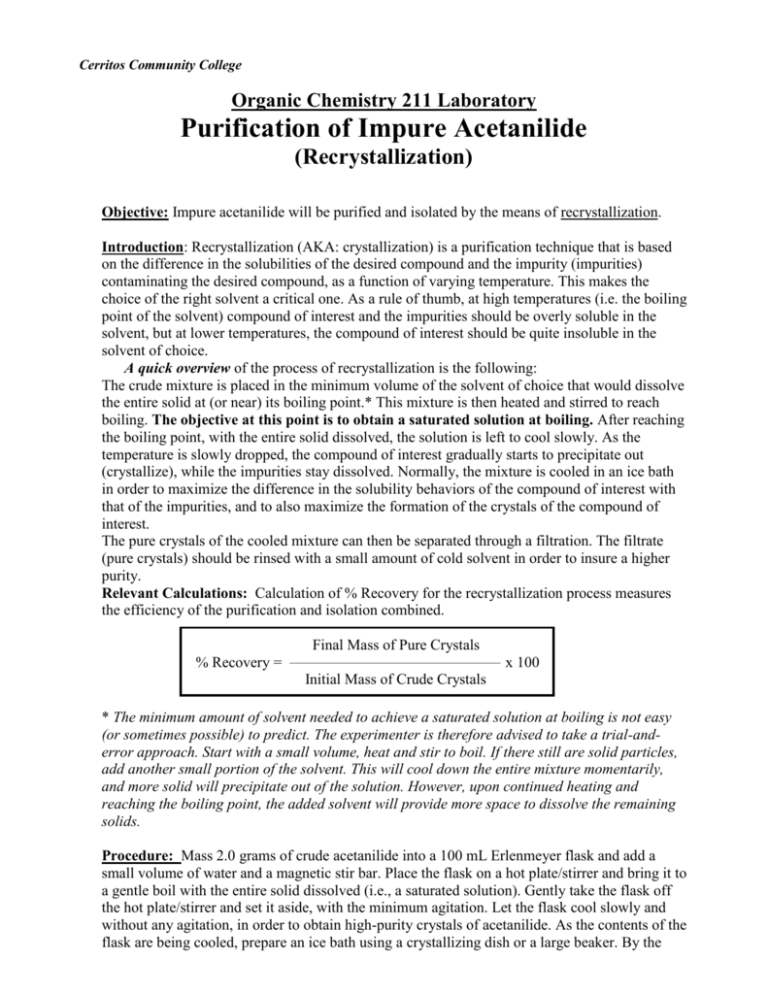
Cerritos Community College Organic Chemistry 211 Laboratory Purification of Impure Acetanilide (Recrystallization) Objective: Impure acetanilide will be purified and isolated by the means of recrystallization. Introduction: Recrystallization (AKA: crystallization) is a purification technique that is based on the difference in the solubilities of the desired compound and the impurity (impurities) contaminating the desired compound, as a function of varying temperature. This makes the choice of the right solvent a critical one. As a rule of thumb, at high temperatures (i.e. the boiling point of the solvent) compound of interest and the impurities should be overly soluble in the solvent, but at lower temperatures, the compound of interest should be quite insoluble in the solvent of choice. A quick overview of the process of recrystallization is the following: The crude mixture is placed in the minimum volume of the solvent of choice that would dissolve the entire solid at (or near) its boiling point.* This mixture is then heated and stirred to reach boiling. The objective at this point is to obtain a saturated solution at boiling. After reaching the boiling point, with the entire solid dissolved, the solution is left to cool slowly. As the temperature is slowly dropped, the compound of interest gradually starts to precipitate out (crystallize), while the impurities stay dissolved. Normally, the mixture is cooled in an ice bath in order to maximize the difference in the solubility behaviors of the compound of interest with that of the impurities, and to also maximize the formation of the crystals of the compound of interest. The pure crystals of the cooled mixture can then be separated through a filtration. The filtrate (pure crystals) should be rinsed with a small amount of cold solvent in order to insure a higher purity. Relevant Calculations: Calculation of % Recovery for the recrystallization process measures the efficiency of the purification and isolation combined. Final Mass of Pure Crystals % Recovery = __________________________________________ x 100 Initial Mass of Crude Crystals * The minimum amount of solvent needed to achieve a saturated solution at boiling is not easy (or sometimes possible) to predict. The experimenter is therefore advised to take a trial-anderror approach. Start with a small volume, heat and stir to boil. If there still are solid particles, add another small portion of the solvent. This will cool down the entire mixture momentarily, and more solid will precipitate out of the solution. However, upon continued heating and reaching the boiling point, the added solvent will provide more space to dissolve the remaining solids. Procedure: Mass 2.0 grams of crude acetanilide into a 100 mL Erlenmeyer flask and add a small volume of water and a magnetic stir bar. Place the flask on a hot plate/stirrer and bring it to a gentle boil with the entire solid dissolved (i.e., a saturated solution). Gently take the flask off the hot plate/stirrer and set it aside, with the minimum agitation. Let the flask cool slowly and without any agitation, in order to obtain high-purity crystals of acetanilide. As the contents of the flask are being cooled, prepare an ice bath using a crystallizing dish or a large beaker. By the time the mixture is cooled to room temperature, pure crystals of acetanilide must have formed. Otherwise try gently scratching the inner walls of the container with a glass stirring rod. This will initiate the crystallization process. With the mixture at room-temperature, and crystals formed, place the flask in ice bath, to optimize the conditions for crystallization. Meanwhile set up a vacuum filtration apparatus, using the small filtration flask, and the Hirsch funnel equipped with built-in plug. Also, place a 1-2 mL portion of water (the solvent) to cool in the ice bath. After about 5-10 minutes of cooling, filter the contents of the flask. If any crystals are stuck to the walls of the flask, use a microspatula (with the tip bent) to scoop out all the crystals, and to place them on the filter. Wash the crystals collected on the Hirsch funnel, with the small amount of chilled water. Let the crystals air dry. In order to speed up the drying process, the crystals could be transferred onto a medium sized filter paper. Measure the mass of the recovered, dry, and pure crystals of acetanilide. Measure the melting point for the purified acetanilide twice. Also perform a parallel measurement of the melting point for pure acetanilide sample, provided by your instructor. This will serve as a reference point to compare to. For the report: 1. Determine the %Recovery for the recrystallization process. 2. Calculate the % error in the melting point of the purified acetanilide, with the correct value being the melting point for the pure acetanilide sample, provided by your instructor. Questions: 1. 2. 3. 4. Why should a small volume of the solvent be used for rinsing the pure crystals? Why should the rinsing solvent be cold? How does “scratching” initiate crystallization? Compare the melting point for the pure sample provided by your instructor, with the literature value. Is there any difference? If yes, then calculate the % error associated. Needed (per student): Crude acetanilide (2 grams) ------------------------------- 30 grams per lab Pure acetanilide (small amount for melting point measurement)
